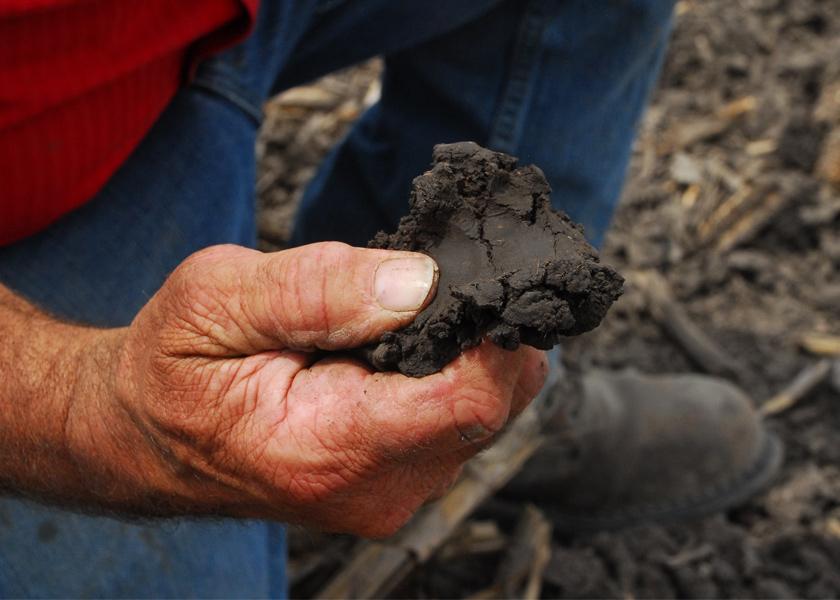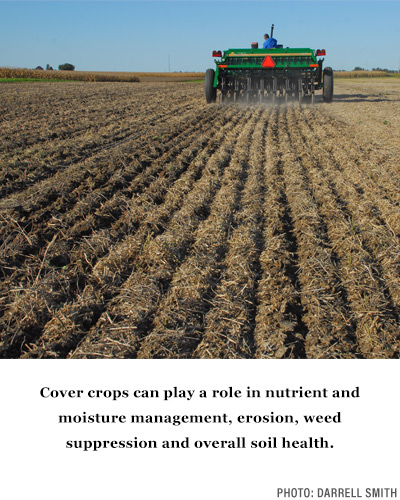9 Tips for Improving Soil Health on Your Farm

Create a groundwork for high yields and profitability
Farmers know improving soil health can supercharge crop performance. However, it’s not always clear what steps or adjustments a farmer can take to see real results. Try these nine strategies first to transform soil from good to great.
1. START WITH THE FOUNDATION
First, look at how well water moves up and down the soil profile, says Farm Journal Field Agronomist Ken Ferrie. “One of the biggest issues affecting soil health a lot of times are past sins, such as compaction layers that restrict root and water movement limiting soil oxygen.”
If flipping a field’s soil health is the goal, he says, it might require deep tillage to remove layers or improving field drainage with tile before adding other systems like cover crops or no-till.
2. KEEP A LIVING ROOT
“The soil is alive; in one teaspoon of healthy soil there are more microbes than there are people on the earth,” says Mitchell Hora, CEO of Continuum Ag. “Those microbes need to eat, which means we need to pump more carbon and simple sugars into the ground via photosynthesis.”
Without living roots, microbes can die off and processes such as nutrient cycling, water management, building aggregate stability, improving water holding capacity, storing carbon or building organic matter all stop.
3. TAKE A HOLISTIC APPROACH
“The whole farm, every single acre, works in tandem because the environment all works together,” says Jamie Johnson, a farmer in Frankfort, S.D., and 2022 regional winner of the American Soybean Association Conservation Legacy Award. “We try to approach it as a whole system.”
For them, that means incorporating other types of agriculture back into the operation, such as livestock to provide added nutrients, organic matter and biodiversity.
4. ADOPT PRECISION AG
Precision ag practices, such as variable rate applications and creating management zones, can save farmers money and resources by limiting over or under application while focusing on improving overall soil heath.
“If we can tell through precision ag applications a soil type is not able to produce a certain number of bushels, then there’s no reason to plan for bushels beyond its ability because the soil is the limitation,” says Neil Dominy, assistant state conservationist for partnerships for the Nebraska Natural Resources Conservation Service. “Management zones can help us dial that in.”
5. BALANCE SOIL PH
The bacteria that break down organic matter don’t work well in highly acidic soils. Organic matter can tie up important nutrients, including nitrogen. A pH range of 6 to 7 is optimum for making sure nutrients are available to plants, although most field crops work well between 5.5 and 6.5.
“We always think about nutrients producing a big crop, but those nutrients also feed the microbial biology in the soil,” Ferrie says. “If a farm is too acidic, for instance, it really slows down the biology.”
6. NO-TILL CEREAL RYE AHEAD OF SOYBEANS
Farmers looking for an easy place to start should consider no-tilling cereal rye as a cover crop in the fall ahead of next season’s soybeans.
“In that soybean year, you can drill your soybeans or plant your soybeans green and then let the rye keep growing,” Hora says. “You’re getting the benefit of that rye managing your moisture while feeding nutrients back to the seedbed.”

7. MINIMIZE DISTURBANCE
Farmers focusing on soil health should limit or minimize disturbance of soil, Hora says.
“If you’re building those microbial communities up but then destroy their home with tillage or over application of fertilizers, what good are we really doing?” he asks.
By limiting disturbance, you can help improve aggregate stability, add pores, improve carbon sequestration and increase water infiltration.
8. PLANT GREEN, TERMINATE RYE LATER
Before you terminate a cover crop such as rye, wait until it starts to drop pollen, or the soil becomes dry after soybeans are up and growing. Then hit the field with a single herbicide pass on a day when rain is not in the forecast.
“This lets you reduce that early pass of herbicide,” Hora explains. “We don’t need a pre-emerge, we don’t need that preplanting pass of herbicide or even that early post- emerge pass.”
He currently relies on a quart of generic glyphosate. If you want to eliminate chemistry further, use a roller or crimper to terminate rye even in soybeans between V1 and V3.
9. BE ON OFFENSE, NOT DEFENSE
“Often cover crops and no-till have been branded as defensive management tools — defense against erosion and defense against water quality problems — but really that cover crop is my offensive tool,” Hora says. “It’s my nutrient stabilizer, it’s my herbicide program, it’s my moisture management program, it’s my soil building program, it’s my resiliency program.”
Farm Journal Editor Clinton Griffiths is a TV newsman turned magazine editor with a passion for good stories. He believes the best life lessons can be found down a dirt road.







